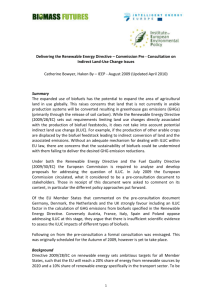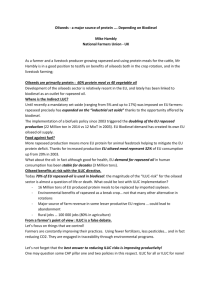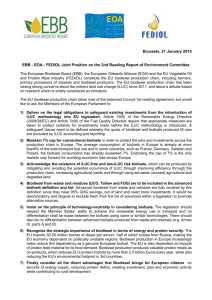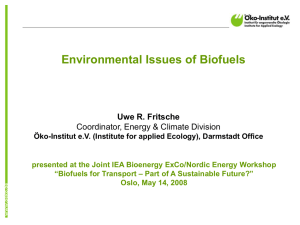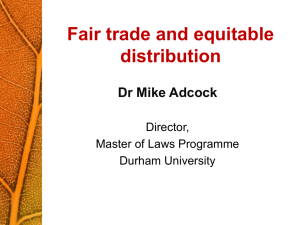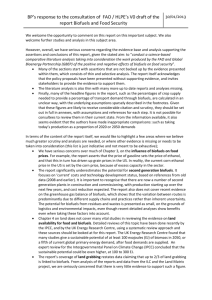Background Document
advertisement
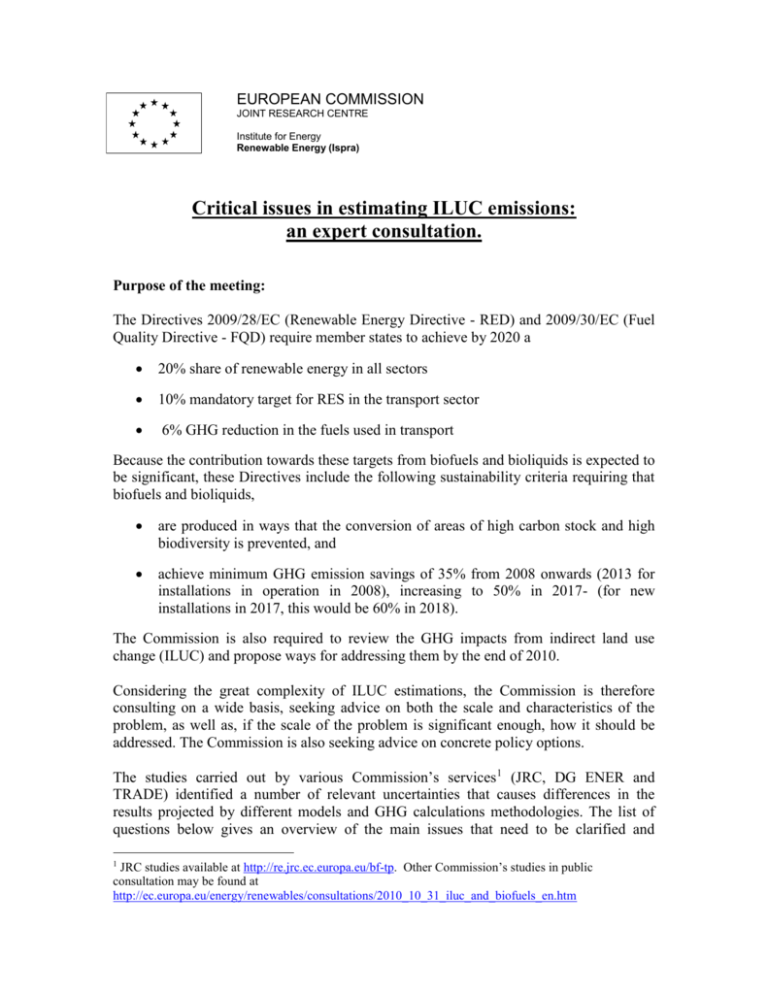
EUROPEAN COMMISSION JOINT RESEARCH CENTRE Institute for Energy Renewable Energy (Ispra) Critical issues in estimating ILUC emissions: an expert consultation. Purpose of the meeting: The Directives 2009/28/EC (Renewable Energy Directive - RED) and 2009/30/EC (Fuel Quality Directive - FQD) require member states to achieve by 2020 a 20% share of renewable energy in all sectors 10% mandatory target for RES in the transport sector 6% GHG reduction in the fuels used in transport Because the contribution towards these targets from biofuels and bioliquids is expected to be significant, these Directives include the following sustainability criteria requiring that biofuels and bioliquids, are produced in ways that the conversion of areas of high carbon stock and high biodiversity is prevented, and achieve minimum GHG emission savings of 35% from 2008 onwards (2013 for installations in operation in 2008), increasing to 50% in 2017- (for new installations in 2017, this would be 60% in 2018). The Commission is also required to review the GHG impacts from indirect land use change (ILUC) and propose ways for addressing them by the end of 2010. Considering the great complexity of ILUC estimations, the Commission is therefore consulting on a wide basis, seeking advice on both the scale and characteristics of the problem, as well as, if the scale of the problem is significant enough, how it should be addressed. The Commission is also seeking advice on concrete policy options. The studies carried out by various Commission’s services 1 (JRC, DG ENER and TRADE) identified a number of relevant uncertainties that causes differences in the results projected by different models and GHG calculations methodologies. The list of questions below gives an overview of the main issues that need to be clarified and JRC studies available at http://re.jrc.ec.europa.eu/bf-tp. Other Commission’s studies in public consultation may be found at http://ec.europa.eu/energy/renewables/consultations/2010_10_31_iluc_and_biofuels_en.htm 1 discussed to reduce the uncertainties in ILUC estimations and to explain the reasons for differences in results from various models. At the end of this expert consultation, we should be able to have a better understanding of the following key questions for the policy process: 1) does the modelling provide a good basis for determining how significant indirect land use change resulting from the production of biofuels and bioliquids2 is? 2) are the impacts significant? 3) can we differentiate between a) bioethanol/biodiesel b) feedstocks, c) geographical areas d) production methods (i.e. ILUC mitigation actions) 2 All references to biofuels in this document also apply to bioliquids Session 1: Land Use change and GHG emissions. Session 1.A: METHODOLOGIES : are the available studies adequate to determine how significant ILUC resulting form production of biofuels is? 1. Accounting for extra land: Which are the best criteria to drive spatial allocation of extra cropland from biofuels production, and what are the parameters defining the conversion of non crop-land to cropland? Land suitability, socio-economic criteria (e.g. cost of land, production costs, rate of return), others? Which proportions of new cropland will go onto forest, shrubland and pasture? (historical data vs modeled data) Would results be significantly affected by forecasting land cover, climate and management systems for 2020? How could this be done? 2. GHG emissions from ILUC: What principal methodologies are used to convert land cover changes to GHG emissions? (IPCC Tier1 approach)? Is it right to use figures that represent 100% maturity of forest and grassland? Would increasing future nature protection areas significantly affect ILUC emission estimates? Can models account for this? Will sustainability criteria for biofuels have significant effects on this allocation? What percentage of palm oil (and other crops) will be produced on plantations on peatland? Does deforestation for crops save deforestation for logging elsewhere? Conversely, how significant is the acceleration of logging due to road construction for farming and is this modelled? How should foregone sequestration be treated in selectively logged forests, or where cropped area has declined? Session 1.B: DATA AND UNCERTAINTIES: are the available datasets adequate to calculate emissions from ILUC? Are all the relevant parameters effectively considered by different methodologies? 1. Availability and use of datasets to calculate emissions: Do the datasets adequately show land availability? (e.g. in EU and CIS). What is the magnitude of GHG emissions per hectare from draining peatland and how do emission estimates compare to IPCC default values? 2. Data and models uncertainties: What are the uncertainties the various datasets use to define cropland areas and land use/cover maps (e.g. MODIS, FAO, M3, GLOBCOVER, land suitability etc...). When do differences in ancillary data significantly affect results? Is it justified to assume that no additional crop area falls in the higher class of organic carbon for mineral soils? Session 2: Agro-economic modeling and uncertainties: how does the range of existing estimates change the results? 1. Intensification Animal husbandry: if pasture is lost to cropland, to what extent will this result in increasing stock density on the remaining pasture, and to what extent will it incentivize deforestation for more pasture? What do the models assume? Double/multiple cropping: do models account for the effect of crop price on the incidence of double- (or multiple-) cropping? How significant is this effect? Fertilizers: how much more fertilizer would be required to achieve the extra yields? What is the effect on emissions per tonne of crops? 2. Yields What is the yield on new cropland compared to the yield on existing cropped area and what is the dependence on different regions (Brazil, Indonesia, Africa, U.S., EU, India and China)? How significant is the effect of price (due to demand increase) on the rate of increase of yield due to faster technology improvement? How can models include this? How much of an increase in demand for biofuels will be met by yield growth compared to land use change (i.e. yield elasticity vs area elasticity)? Are the elasticities values and yields assumptions in models appropriate? 3. ILUC reductions How big is the effect of by-products in the models and how do biofuels affect the price of animal feed?. What effect do changes in animal feed use have on the area of pasture?. What do models assume? How much are ILUC emissions reduced by a reduction in food consumption? Should we remove this effect from ILUC emission results? 4. Food commodity markets To what extent would different vegetable oils/cereals substitute each other in the market, over the long-term? To what extent would different co-products substitute other oils? To what extent is the shock of an increase in demand for feedstock for biofuel spread between: The ‘shock’ region? Its trading partners? The World? Are these Armington parameters appropriately estimated by econometrics? What do different models assume for the substitution of oil meals? (is an economic or mass- based substitution appropriate?) Session 3. The marginal fossil fuel What will be the proportion of the different crudes in the marginal oil for the EU in 2020? What would be representative values of the weighted average marginal emissions from extraction and refining of fossil oil? Session 4: CONCLUSIONS: Policy options Does the modeling provide a good basis for determining how significant ILUC resulting from biofuels production is?. If so, what is in your view the likely magnitude of these impacts to 2020 as a whole based on current demand projections3, and how they will compare with the savings offered over a 20 year period? Is it possible to differentiate between a) bioethanol/biodiesel b) biofuel feedstocks c) geographical areas and d) production methods (i.e. ILUC mitigation practices such as the use of degraded land)?. Is the marginal approach suitable for the purpose of biofuels - ILUC analysis? - Can we consider the models linear? - If not, what is the correct amount of biofuels in the baseline of the models? How would you calculate an‘ILUC’ factor? How often would you review it, how and why (how to treat new data and new assumptions – grandfathering etc.)? How effective would be the option of increasing the minimum greenhouse gas saving threshold for biofuels be inpreventing negative ILUC effects?. What level would this need to be raised to? How can the risk of ILUC be minimized through other policy actions in the context of the Renewable Energy and Fuel Quality Directives? 3 Current member states projections suggest an increase in biofuel demand of 5 Mtoe for bioethanol and 12 Mtoe for biodiesel to 2020 based from 2008 levels. In addition, total demand for bioliquids in 2020 is expected raise to 5Mtoe.
